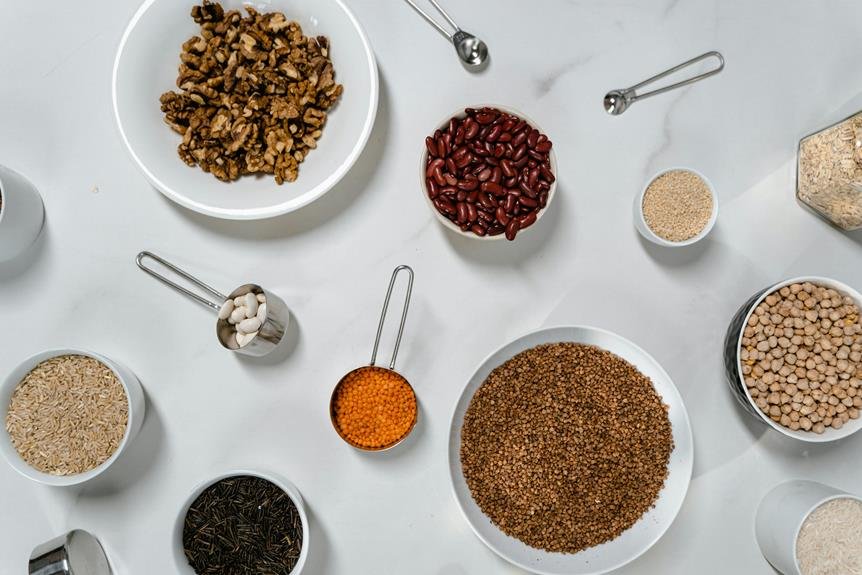
When it comes to simplifying high-fiber meal preparation, blenders are your unsung heroes. The way they effortlessly transform hearty ingredients into smooth and palatable dishes is a game-changer. But how exactly can blenders tackle the challenges of incorporating more fiber into your diet? Stay tuned as we unravel the secrets behind harnessing the power of blenders to make your high-fiber meal prep a breeze.
Benefits of Using Blenders for Fiber-Rich Meals
When preparing fiber-rich meals, using blenders enhances the overall nutritional value and aids in easier digestion. By blending fruits, vegetables, and other high-fiber ingredients, you break down the cellular structure, making it easier for your body to extract and absorb essential nutrients. Blending also helps in creating a smooth texture, which can be more appealing and easier to consume, especially for those who struggle with chewing tough fibers. The high-speed blending process can assist in breaking down tough plant fibers, making them more palatable while retaining their beneficial nutrients.
Additionally, blenders allow you to mix a variety of high-fiber ingredients together, creating delicious and nutritious smoothies, soups, or sauces. This versatility enables you to experiment with different flavor combinations and textures, making it easier to incorporate a wide range of fiber-rich foods into your diet. Furthermore, using blenders can save you time in meal preparation, as they quickly and efficiently process ingredients, helping you whip up nutritious meals even on busy days.
Essential Blending Techniques for High-Fiber Ingredients
To effectively blend high-fiber ingredients, ensuring a smooth and nutritious outcome, consider employing specific techniques that optimize the breakdown and integration of fibrous components.
Start by chopping your ingredients into smaller pieces to facilitate blending. This preparatory step helps the blender process the fibrous foods more efficiently, resulting in a smoother texture.
Additionally, layering ingredients properly can enhance the blending process. Begin with liquids like water or juice at the bottom to create a liquid base that aids in moving the fibers around. Follow this with softer ingredients like fruits or vegetables, and then add the tougher, fibrous elements on top.
Pulse blending is another useful technique for high-fiber ingredients. Using short bursts of blending followed by brief pauses helps break down tough fibers gradually, preventing clumping and ensuring a well-mixed consistency.
Creative High-Fiber Blending Recipe Ideas
Get ready to blend your way to delicious and nutritious high-fiber meals with these creative recipe ideas. Start your day with a refreshing green smoothie by blending together spinach, kale, banana, and a sprinkle of chia seeds for an extra fiber boost. For a satisfying snack, try making a creamy avocado and white bean hummus dip using your blender. Simply blend ripe avocados, white beans, garlic, lemon juice, and a dash of cumin until smooth.
When it comes to high-fiber meals, soups are a fantastic option. Create a hearty vegetable soup by blending together carrots, celery, tomatoes, and lentils for a fiber-rich meal. Another idea is to blend chickpeas, tahini, lemon juice, and roasted red peppers to make a flavorful and fiber-packed hummus spread. Lastly, treat yourself to a sweet dessert by blending frozen berries, Greek yogurt, and a splash of honey for a high-fiber berry smoothie bowl.
These creative blending recipes won't only simplify meal preparation but also ensure you're getting your daily dose of fiber.
Tips for Maintaining Your Blender for Long-Term Use
Proper maintenance of your blender is essential for ensuring its long-term functionality and performance. To keep your blender in top condition, follow these simple tips.
First, after each use, disassemble the blender and wash the components thoroughly with warm, soapy water. Pay special attention to the blender blades to remove any stuck-on residue. Additionally, make sure to dry all parts completely before reassembling to prevent mold or bacteria growth.
Regularly inspect the blender for any signs of wear and tear, such as cracks in the pitcher or dull blades. Replace any damaged parts immediately to avoid compromising the blender's performance. It's also important to avoid overfilling the blender to prevent strain on the motor and ensure smooth blending.
Furthermore, lubricate the blender's gasket periodically to maintain a proper seal and prevent leaks. Finally, store your blender in a dry place away from direct sunlight to prevent discoloration or damage. By following these maintenance tips, you can prolong the lifespan of your blender and continue enjoying delicious high-fiber meals with ease.




